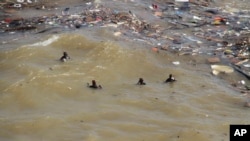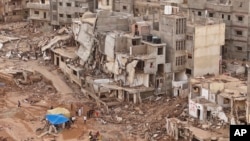Libyan authorities have split the city of Derna into four sections creating buffers amid growing concerns from the United Nations of disease spreading through the city, creating a “second devastating crisis.”
The eastern Libyan city was hit with a destructive flood last week, as heavy rainfall from Mediterranean storm Daniel caused two dams, built in the 1970s, to burst, letting water rush into the city, destroying entire neighborhoods.
Death tolls from the flood have ranged from 4,000 to more than 11,000, and survivors have shown concern over disorganized rescue efforts and uneven aid distribution.
The destructive nature of the flood has left some survivors without homes, or access to food or clean drinking water, which has raised great concern of disease raging through the city, leading to an even greater death toll.
Authorities' decision to divide the city into four regions come one day after hundreds of outraged protesters demonstrated outside of Derna's Sahaba Mosque, demanding accountability be taken by Libyan officials for the result of the flood.
The burst dams had been visibly cracked since 1998, and angered flood survivors have called into question Libyan leaders' negligence towards protecting their infrastructure.
Administration within the region fired the entire city council, along with the mayor of Derna.
Although tensions in Derna cooled on Tuesday, phone lines and the internet had been lost, leading to difficult communication throughout the region, which some journalists were ordered to leave.
Hichem Abu Chkiouat, minister of civil aviation, told Reuters that journalist expulsions were carried out in an effort to help rescue teams.
“It is an attempt to create better conditions for the rescue teams to carry out the work more smoothly and effectively," Chkiouat said.
The U.N. has sent search and rescue teams into the city which are still operating, yet an additional team from Benghazi was blocked. Officials gave no explanation as to why this mission was apparently stopped.










